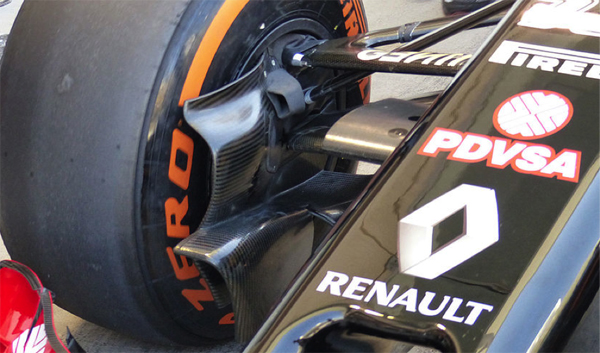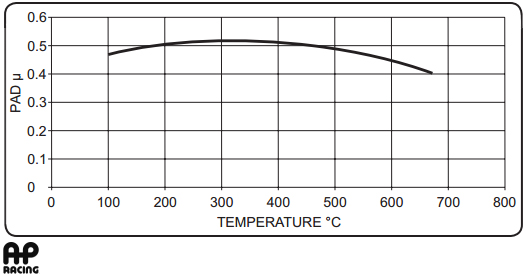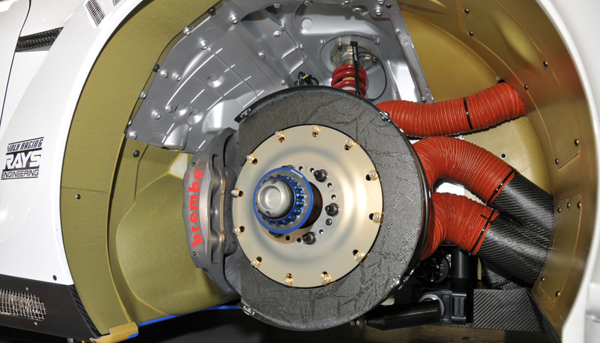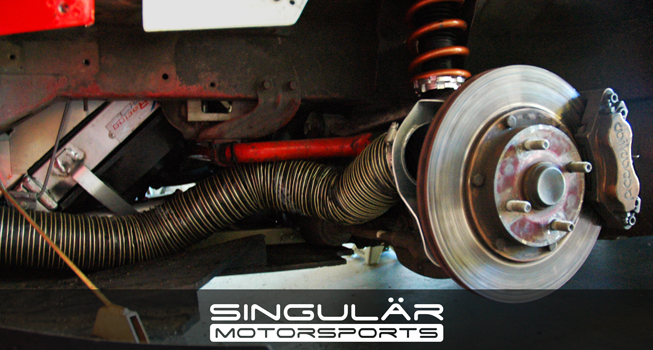Brake ducts are a critical part to a car’s braking system when driven or raced on the track. They are found in nearly every form of road racing from the grassroots level up to Formula One. Across this entire range, the goals are the same: to decrease the operating temperature of the braking system:
Highlights of proper brake cooling include:
- Increases pad friction and stopping power
- Longer brake pad and rotor life
- Consistency in feel and performance
- Increased driver confidence
Brakes generate massive amounts of heat – it is the only system in the car producing heat well over 1,000 degrees F besides the combustion chamber of your motor!
Brake components have a window of temperature which they can operate within, and their performance degrades drastically when they exceed their maximum temperature ratings. The list of problems that arise as the brakes get hotter is scary;
- Glazed brake pads lose grip on the rotor
- Boiling brake fluid
- Calipers will flex and exert uneven pressure on the pads
- Cracked and/or failing rotors
Brake duct intakes in F1:
The Problem
Brake rotors are designed to dissipate heat, but the air in the wheel well and inside the barrel of the wheel is turbulent and slow-moving, which causes the heat to build up around the brakes and diminishes their ability to shed that heat.
Brake ducts work by channeling air from a high pressure source (usually the front surface of the car) to the brake rotor. The air introduced by the brake ducts is much cooler than the brakes, and the airflow continuously moves hot air away and allows the brakes to shed heat at a faster rate. This dramatically lowers the average temperature that the brakes are operating at.
Maximizing your brake’s performance
There is much more to brake cooling than avoiding catastrophic failure. Cooling the brakes is also essential to getting maximum performance.
Brake pad manufacturers list their pad’s effective operating temperature range. Within that temperature range, the pad’s friction ability (grip on the rotor) is not a constant; it falls off as temperature increases. Even staying within the manufacturer’s stated temperature range, a pad operating closer to its limit performs worse than a cooler pad.
This graph from AP Racing illustrates the relationship between friction (y-axis) and temperature (x-axis) for one of their popular brake pads. You can see the friction drop off significantly even within the approved operating range of the pad:
To give some meaning to the numbers above, peak brake temperatures can easily exceed 700 degrees C without any cooling. Even with the best cooling, you’re likely to be above 300 degrees, somewhere on the downward sloping right side of the curve. How far to the right depends on how effective your brake ducting is.
Cooling ducts are critical to getting the best performance from your brakes because they shift the operating temperature leftward on the graph – providing you with more bite and therefore stopping power.
Increasing the lifespan of parts
As the average operating temperature of the brakes increases, the lifespan of the brake pads, rotors, and fluid all decrease.
This issue begins long before you actually exceed the operating range for your brake components.
We see this demonstrated all the time with the difference between a rookie and seasoned driver at the track; For example, in the same car with all the same brake components, a rookie may get 12 track days out of a set of brake pads, whereas the advanced driver is only getting 4 or 5 days from the same setup without ever exceeding the brake’s temperature range.
As your skill increases, you put more heat and stress on the brake components. The average temperature of the brakes rises, and they wear out faster.
Some just accept this as a cost of becoming a faster driver, without realizing that a brake ducting system could get them much of that lifespan back.
Advanced brake cooling systems may use multiple hoses and ducts to focus air on various components, as seen on this Nismo GTR:
Making a Good Brake Duct System
There are three main portions to a brake duct system in a production car with enclosed wheels: The inlet, the hose, and the spindle adapter/outlet.
Inlet
The key for the inlet is for it to be in a high-pressure location. Any inlet on the front of the car will work to a degree. They will be more effective the closer to the center of the bumper you can put them. As you move away from center, the air is traveling sideways over the bumper, not straight on, so inlets further to the sides are less effective. There are lots of DIY solutions out there for the air source, and lots of universal inlets available on the market that you can get creative with.
In racing applications, the inlets are often very low on the bumper, just above the splitter surface because the splitter makes this is a very high pressure area. For cars without a splitter, it is ideal to have the inlets higher up as there is much less pressure along the lower edge of the bumper.
Hose
Hose is the most common method of getting the air from the inlet to the brakes as it is flexible, so it can be routed around the suspension and other obstacles and it can also flex as the wheels turn and the suspension moves.
Hose is available from many online retailers – it’s important to get the kind that is heat resistant. We like the 2-ply neoprene or silicone versions, which can handle direct temperature of 300-500 degrees F depending on the specific construction.
Most hose with a steel spiral-wound support has an accordion shape both inside and out. While this allows the flexibility which is needed in some areas, the downside is that the ridges on the inside create turbulence and slow the airflow. For this reason, many well developed brake duct systems use a combination of smoothly formed tubes where flexibility is not needed, with shorter sections of the flexible hose for the portions which need to articulate.
Size
Choosing a hose size that is too small can handicap your entire brake cooling system.
For the flexible hose, the accordion shape which decreases airflow makes the hose perform as if it is smaller than its actual dimensions. Additionally, any bends in the hose drastically reduce the airflow. Bending the hose is nearly unavoidable though, because the hose must route around obstacles and then turn towards the rotor.
There is one sure way to directly combat these drawbacks – increase the hose diameter. The airflow through the hose increases as a square of the diameter, so even a ½” increase in hose size actually produces a very significant difference, and this highlights why the hose size is so important.
The largest difficulty that arises as hose size increases is getting the orientation just right between the wheel, spindle, sway bar, etc. since tolerances are slim – so a specialized part that locates the hose and its outlet position becomes more critical. That brings us to…
Outlet
This is the part which is usually designed for a specific car, and it does the job of getting the air as close to the brakes as possible. It also locates the hose at a precise orientation to avoid binding or interfering with all of the various moving parts in this area.
Brake rotors are designed to vent air from their center outwards, so the closer to the center of the rotor you can get the air, the better. This is why the Singular Motorsports Brake Ducts are designed with diverter flaps which direct the air towards the center of the rotor even after the air leaves the outlet.
Some DIY solutions try to avoid having an outlet piece, and just place the end of the hose close to the brakes. It’s important to understand that this has safety risks; brake duct hose is wound with steel wire, and while it is nicely contained within the hose along the hose’s length, at the end of the hose it is exposed and it can easily unravel from the hose if it catches on something. We’ve seen more than one catastrophic failure with sudden tire and brake line damage as a result of this. When the hose is clamped to an outlet, the clamp holds the wire in place and prevents this possibility.
3″ Singular Motorsports brake ducts for the Mazda Miata:
Why it makes sense to run brake ducts on nearly ANY track-driven car:
A) Even if you aren’t at the limit of the brake pad/fluid’s operating temperature, decreasing the temps of the brakes can drastically increase their lifespan – in many cases pad life can nearly double (In other words, these pay for themselves over time)
B) A low-power car may be able to run track-only pads and avoid reaching the limits of the pad, but many people in the double-duty street/track category want to run a less than full-track pad that can be used everywhere. In these cases, really good brake ducting can be the key to keeping those pads within their operating temperature range and not destroying them.
3″ Brake Duct vs. “No Duct” Test at Singular Motorsports
I recently ran our 3” version vs. no ducting at the track (taped over the duct inlet on one side of the car). Following a brief half-session, and after a cool down lap which allowed temps to come down and stabilize a bit, on the non-ducted side we saw caliper temps of 585 degrees F. For those of you keeping score, that’s just a breath away from the boiling point of the Motul RBF600.
On the ducted side of the car, the caliper was 445 degrees F. Perfectly happy.
I had intended to do more testing with the side that was blocked off, but after seeing those temps I aborted that plan and kept both sides ducted the rest of the day. I literally would not run my car without these.





